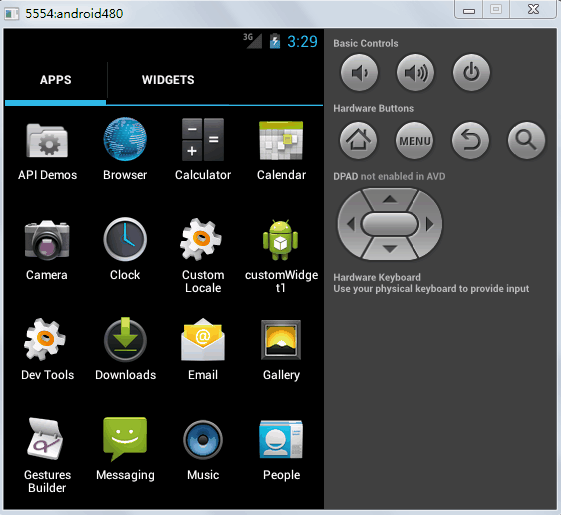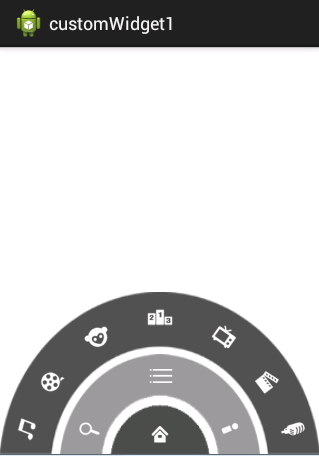android自定义控件之模仿优酷菜单
去年的优酷HD版有过这样一种菜单,如下图:

应用打开之后,先是三个弧形的三级菜单,点击实体键menu之后,这三个菜单依次旋转退出,再点击实体键menu之后,一级菜单会旋转进入,点击一级菜单,二级菜单旋转进入,点击二级菜单的menu键,三级菜单旋转进入,再次点击二级菜单的旋转键,三级菜单又会旋转退出,这时再点击一级菜单,二级菜单退出,最后点击实体menu键,一级菜单退出。
总体来说实现这样的功能:
(1)点击实体menu键时,如果界面上有菜单显示,不管有几个,全部依次退出,如果界面上没有菜单显示,则显示一级菜单。
(2)点击一级菜单的home键时,如果此时界面只有一级菜单,则显示二级菜单,否则让除了一级菜单外的菜单全都依次退出。
(3)点击二级菜单的menu键时,如果三级菜单已经显示,则让它旋转退出,如果三级菜单未显示则让它旋转进入。
好了,今天我们主要实现上述效果。
先来看布局文件
<RelativeLayout xmlns:android="http://schemas.android.com/apk/res/android" xmlns:tools="http://schemas.android.com/tools" android:layout_width="match_parent" android:layout_height="match_parent" tools:context="com.example.customwidget.MainActivity" > <RelativeLayout android:id="@+id/menu_level1" android:layout_width="100dp" android:layout_height="50dp" android:layout_alignParentBottom="true" android:layout_centerHorizontal="true" android:background="@drawable/level1" > <ImageButton android:id="@+id/level1_home" android:layout_width="wrap_content" android:layout_height="wrap_content" android:layout_centerInParent="true" android:layout_marginBottom="10dp" android:background="@drawable/icon_home" android:onClick="myClick" /> </RelativeLayout> <RelativeLayout android:id="@+id/menu_level2" android:layout_width="200dp" android:layout_height="100dp" android:layout_alignParentBottom="true" android:layout_centerHorizontal="true" android:background="@drawable/level2" > <ImageButton android:layout_width="wrap_content" android:layout_height="wrap_content" android:layout_alignParentBottom="true" android:layout_marginBottom="10dp" android:layout_marginLeft="15dp" android:background="@drawable/icon_search" /> <ImageButton android:id="@+id/level2_menu" android:layout_width="wrap_content" android:layout_height="wrap_content" android:layout_centerHorizontal="true" android:layout_marginTop="7dp" android:background="@drawable/icon_menu" android:onClick="myClick" /> <ImageButton android:layout_width="wrap_content" android:layout_height="wrap_content" android:layout_alignParentBottom="true" android:layout_alignParentRight="true" android:layout_marginBottom="10dp" android:layout_marginRight="15dp" android:background="@drawable/icon_myyouku" /> </RelativeLayout> <RelativeLayout android:id="@+id/menu_level3" android:layout_width="320dp" android:layout_height="162dp" android:layout_alignParentBottom="true" android:layout_centerHorizontal="true" android:background="@drawable/level3" > <ImageButton android:id="@+id/level3_channel1" android:layout_width="wrap_content" android:layout_height="wrap_content" android:layout_alignParentBottom="true" android:layout_marginBottom="10dp" android:layout_marginLeft="12dp" android:background="@drawable/channel1" /> <ImageButton android:id="@+id/level3_channel2" android:layout_width="wrap_content" android:layout_height="wrap_content" android:layout_above="@id/level3_channel1" android:layout_marginBottom="17dp" android:layout_marginLeft="-5dp" android:layout_toRightOf="@id/level3_channel1" android:background="@drawable/channel2" /> <ImageButton android:layout_width="wrap_content" android:layout_height="wrap_content" android:layout_above="@id/level3_channel2" android:layout_marginBottom="15dp" android:layout_marginLeft="13dp" android:layout_toRightOf="@id/level3_channel2" android:background="@drawable/channel3" /> <ImageButton android:layout_width="wrap_content" android:layout_height="wrap_content" android:layout_centerHorizontal="true" android:layout_marginTop="10dp" android:background="@drawable/channel4" /> <ImageButton android:id="@+id/level3_channel7" android:layout_width="wrap_content" android:layout_height="wrap_content" android:layout_alignParentBottom="true" android:layout_alignParentRight="true" android:layout_marginBottom="10dp" android:layout_marginRight="12dp" android:background="@drawable/channel7" /> <ImageButton android:id="@+id/level3_channel6" android:layout_width="wrap_content" android:layout_height="wrap_content" android:layout_above="@id/level3_channel7" android:layout_marginBottom="17dp" android:layout_marginRight="-5dp" android:layout_toLeftOf="@id/level3_channel7" android:background="@drawable/channel6" /> <ImageButton android:layout_width="wrap_content" android:layout_height="wrap_content" android:layout_above="@id/level3_channel6" android:layout_marginBottom="15dp" android:layout_marginRight="13dp" android:layout_toLeftOf="@id/level3_channel6" android:background="@drawable/channel5" /> </RelativeLayout>
</RelativeLayout>
- 1
- 2
- 3
- 4
- 5
- 6
- 7
- 8
- 9
- 10
- 11
- 12
- 13
- 14
- 15
- 16
- 17
- 18
- 19
- 20
- 21
- 22
- 23
- 24
- 25
- 26
- 27
- 28
- 29
- 30
- 31
- 32
- 33
- 34
- 35
- 36
- 37
- 38
- 39
- 40
- 41
- 42
- 43
- 44
- 45
- 46
- 47
- 48
- 49
- 50
- 51
- 52
- 53
- 54
- 55
- 56
- 57
- 58
- 59
- 60
- 61
- 62
- 63
- 64
- 65
- 66
- 67
- 68
- 69
- 70
- 71
- 72
- 73
- 74
- 75
- 76
- 77
- 78
- 79
- 80
- 81
- 82
- 83
- 84
- 85
- 86
- 87
- 88
- 89
- 90
- 91
- 92
- 93
- 94
- 95
- 96
- 97
- 98
- 99
- 100
- 101
- 102
- 103
- 104
- 105
- 106
- 107
- 108
- 109
- 110
- 111
- 112
- 113
- 114
- 115
- 116
- 117
- 118
- 119
- 120
- 121
- 122
- 123
- 124
- 125
- 126
- 127
- 128
- 129
- 130
- 131
- 132
- 133
这里是一个相对布局中嵌套了三个相对布局,嵌套的第一个相对布局负责显示一级菜单,嵌套的第二个相对布局负责显示二级菜单,嵌套的第三个相对布局负责显示三级菜单。三个不同层次的菜单的背景都是弧形。我们通过指定具体的宽高来使三个层次的菜单具有不同的大小。
效果如下:

再看看MainActivity.java
/**
* 模仿优酷菜单
* 2015年5月19日
*/
public class MainActivity extends Activity { //分别拿到不同等级的菜单 private RelativeLayout lv1; private RelativeLayout lv2; private RelativeLayout lv3; private Animation animation; //各级菜单是否显示,默认全都显示 private boolean isDisplaylv1 = true; private boolean isDisplaylv2 = true; private boolean isDisplaylv3 = true; //动画是否正在执行,默认动画没有执行 private boolean isAnimationRunning = false; @Override protected void onCreate(Bundle savedInstanceState) { super.onCreate(savedInstanceState); setContentView(R.layout.activity_main); lv1 = (RelativeLayout) this.findViewById(R.id.menu_level1); lv2 = (RelativeLayout) this.findViewById(R.id.menu_level2); lv3 = (RelativeLayout) this.findViewById(R.id.menu_level3); } @Override public boolean onKeyDown(int keyCode, KeyEvent event) { //如果动画正在执行,则不处理此事件 if (isAnimationRunning) return super.onKeyDown(keyCode, event); //如果点击的是菜单键 if (keyCode == KeyEvent.KEYCODE_MENU) { //如果一级菜单已经显示,判断二级菜单是否显示 if (isDisplaylv1) { //设置动画启动延迟时间 int startOffset = 0; //如果二级菜单已经显示,判断三级菜单是否显示,然后退出二级菜单 if (isDisplaylv2) { if (isDisplaylv3) { //如果三级菜单已经显示,执行退出动画 exitAnimation(lv3, startOffset); //三级菜单退出动画执行完毕之后,动画的启动时间延迟500ms startOffset += 500; isDisplaylv3 = !isDisplaylv3; } //二级菜单退出,此时startOffset=500,即动画启动时间延迟500ms exitAnimation(lv2, startOffset); //二级菜单退出动画执行完毕之后,动画的启动时间延迟500ms startOffset += 500; isDisplaylv2 = !isDisplaylv2; } //一级菜单退出,此时startOffset=1000,即动画启动时间延迟1000ms exitAnimation(lv1, startOffset); //如果一级菜单未显示,则一级菜单进入 } else { enterAnimation(lv1); } isDisplaylv1 = !isDisplaylv1; return true; } return super.onKeyDown(keyCode, event); } public void myClick(View v) { //如果动画正在执行,则不处理此事件 if (isAnimationRunning) return; switch (v.getId()) { /** * 当点击二级菜单的menu时,如果三级菜单已经显示,则执行退出动画, * 否则执行进入动画 */ case R.id.level2_menu: if (isDisplaylv3) { exitAnimation(lv3, 0); } else { enterAnimation(lv3); } isDisplaylv3 = !isDisplaylv3; break; case R.id.level1_home: // 如果二级菜单已经显示,再判断三级菜单是否显示 if (isDisplaylv2) { //通过设置动画启动延迟时间,来实现动画依次退出效果 int startOffset = 0; // 如果三级菜单也显示了,则让他们依次退出 if (isDisplaylv3) { exitAnimation(lv3, startOffset); startOffset = 700; isDisplaylv3 = !isDisplaylv3; } exitAnimation(lv2, startOffset); isDisplaylv2 = !isDisplaylv2; // 如果二级菜单没有显示,就让二级菜单显示出来 } else { enterAnimation(lv2); isDisplaylv2 = !isDisplaylv2; } break; } } /** * 退出动画 * @param layout 执行动画的布局文件 * @param startOffset 动画启动的延迟时间 */ public void exitAnimation(RelativeLayout layout, long startOffset) { animation = AnimationUtils.loadAnimation(this, R.anim.exit_menu); animation.setFillAfter(true); animation.setStartOffset(startOffset); animation.setAnimationListener(new MyAnimationListener()); layout.startAnimation(animation); } /** * 进入动画 * @param layout 执行动画的布局文件 */ public void enterAnimation(RelativeLayout layout) { animation = AnimationUtils.loadAnimation(this, R.anim.enter_menu); animation.setFillAfter(true); animation.setAnimationListener(new MyAnimationListener()); layout.startAnimation(animation); } /** * 判断动画是否正在执行 * @author 王松 * */ private class MyAnimationListener implements AnimationListener { //动画开始执行 @Override public void onAnimationStart(Animation animation) { isAnimationRunning = true; } //动画执行结束 @Override public void onAnimationEnd(Animation animation) { isAnimationRunning = false; } @Override public void onAnimationRepeat(Animation animation) { } }
}
- 1
- 2
- 3
- 4
- 5
- 6
- 7
- 8
- 9
- 10
- 11
- 12
- 13
- 14
- 15
- 16
- 17
- 18
- 19
- 20
- 21
- 22
- 23
- 24
- 25
- 26
- 27
- 28
- 29
- 30
- 31
- 32
- 33
- 34
- 35
- 36
- 37
- 38
- 39
- 40
- 41
- 42
- 43
- 44
- 45
- 46
- 47
- 48
- 49
- 50
- 51
- 52
- 53
- 54
- 55
- 56
- 57
- 58
- 59
- 60
- 61
- 62
- 63
- 64
- 65
- 66
- 67
- 68
- 69
- 70
- 71
- 72
- 73
- 74
- 75
- 76
- 77
- 78
- 79
- 80
- 81
- 82
- 83
- 84
- 85
- 86
- 87
- 88
- 89
- 90
- 91
- 92
- 93
- 94
- 95
- 96
- 97
- 98
- 99
- 100
- 101
- 102
- 103
- 104
- 105
- 106
- 107
- 108
- 109
- 110
- 111
- 112
- 113
- 114
- 115
- 116
- 117
- 118
- 119
- 120
- 121
- 122
- 123
- 124
- 125
- 126
- 127
- 128
- 129
- 130
- 131
- 132
- 133
- 134
- 135
- 136
- 137
- 138
- 139
- 140
- 141
- 142
- 143
- 144
- 145
- 146
- 147
- 148
- 149
- 150
- 151
- 152
- 153
代码中注释已经写的很详细了,这里不再赘述。最后在给大家看看两个动画文件:
enter_menu.xml
<?xml version="1.0" encoding="utf-8"?>
<set xmlns:android="http://schemas.android.com/apk/res/android" android:shareInterpolator="true"> <rotate
android:duration="1000" android:fromDegrees="-180" android:toDegrees="0" android:pivotX="50%" android:pivotY="100%" />
</set>
- 1
- 2
- 3
- 4
- 5
- 6
- 7
- 8
- 9
- 10
exit_menu.xml
<?xml version="1.0" encoding="utf-8"?>
<set xmlns:android="http://schemas.android.com/apk/res/android" android:shareInterpolator="true"> <rotate
android:duration="1000" android:fromDegrees="0" android:toDegrees="-180" android:pivotX="50%" android:pivotY="100%" />
</set>
- 1
- 2
- 3
- 4
- 5
- 6
- 7
- 8
- 9
- 10
关于动画如果不太懂可以看这里android之tween动画详解,android之frame动画详解。。
文章来源: wangsong.blog.csdn.net,作者:_江南一点雨,版权归原作者所有,如需转载,请联系作者。
原文链接:wangsong.blog.csdn.net/article/details/45842963
- 点赞
- 收藏
- 关注作者


评论(0)